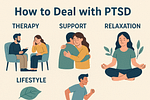Finding the Right Help for PTSD
Post-Traumatic Stress Disorder (PTSD) can deeply affect how you think, feel, and live. For those coping with painful memories, anxiety, or emotional numbness, it’s natural to wonder what can truly help. The good news? Many PTSD treatment options are effective, personalized, and scientifically supported.
From traditional talk therapy to modern brain-based techniques and holistic methods, this article breaks down the top choices available, so you or someone you love can begin the journey to healing.
1. Understanding PTSD: What Triggers the Need for Treatment
PTSD may arise after a person goes through or observes a deeply distressing or traumatic event, including:
- Military combat
- Natural disasters
- Physical or sexual assault
- Car accidents
- Childhood abuse
Not everyone responds to trauma the same way. Some may recover naturally, while others experience ongoing symptoms like flashbacks, nightmares, hypervigilance, or emotional detachment.
If these symptoms persist for more than a month, it’s time to explore PTSD treatment options.
2. Cognitive Behavioral Therapy (CBT)
CBT is among the most commonly suggested therapies for managing PTSD symptoms. It helps people recognize and replace negative thought patterns that contribute to fear and anxiety.
How It Works:
- Patients explore how thoughts and beliefs are shaped by trauma.
- Therapists guide them to challenge and replace these beliefs.
- Through repeated sessions, individuals learn healthier ways to manage their emotions and cope.
Why it’s effective:
CBT is goal-oriented and backed by decades of clinical research.
3. Prolonged Exposure Therapy (PE)
Exposure therapy, a type of CBT, slowly helps individuals face and process trauma-related memories or situations in a safe environment.
Key Features:
- Facing fears in a safe environment
- Repeated retelling of the traumatic event
- Breathing and relaxation techniques
Goal: Desensitize emotional responses and reduce avoidance.
Best for: People with intense flashbacks or avoidance behaviors.
4. Eye Movement Desensitization and Reprocessing (EMDR)
EMDR is a powerful therapy that uses guided eye movements to help the brain process and reframe traumatic memories.
What to Expect:
- The patient focuses on a traumatic memory.
- Simultaneously, they follow a therapist’s hand movements or audio cues.
- Over time, the memory becomes less distressing.
Why it works:
It bypasses the part of the brain where trauma “gets stuck,” allowing natural healing to resume.
5. Narrative Exposure Therapy (NET)
NET is especially useful for people who’ve experienced multiple traumas, such as refugees or abuse survivors.
Process:
- Patients create a timeline of their lives.
- Each traumatic experience is revisited in a structured and supportive way.
- The purpose is to help individuals understand their trauma as one part of their overall life journey.
Benefit:
The aim is to integrate the traumatic experience into the larger narrative of one’s life.
6. PTSD-Focused Group Therapy
Sometimes, PTSD treatment options for healing happen best in the community.
How Group Therapy Helps:
- Reduces isolation and shame
- Provides peer support and validation
- Offers shared coping strategies
These group sessions are typically guided by a licensed therapist and follow an organized, goal-oriented approach.
Ideal for: Individuals who find strength in shared experiences.
7. Medication as a PTSD Treatment Option
While therapy is the foundation of PTSD recovery, medication can be a helpful companion.
Common Medications:
- SSRIs (e.g., sertraline, paroxetine): Help regulate mood and reduce anxiety.
- SNRIs (e.g., venlafaxine): Often used when SSRIs are ineffective.
- Prazosin: Sometimes prescribed to reduce trauma-related nightmares.
Note: Medication should always be prescribed and monitored by a qualified healthcare provider.
8. Somatic Therapies
These treatments focus on the mind-body connection.
Examples:
- Somatic Experiencing: Teaches body awareness to release trauma stored in muscles and nerves.
- Sensorimotor Psychotherapy: Integrates body movement into traditional therapy models.
Why it matters:
Trauma is frequently stored in the body and shows up as physical tension or discomfort. Releasing it physically can lead to emotional breakthroughs.
9. Yoga and Mindfulness-Based Stress Reduction (MBSR)
Holistic practices like yoga and mindfulness help calm the nervous system and increase self-awareness.
Benefits:
- Regulates breathing and heart rate
- Reduces stress hormones like cortisol
- Enhances focus and emotional control
MBSR programs combine gentle movement, meditation, and group support to lower PTSD symptoms over time.
10. Virtual Reality Exposure Therapy as a PTSD treatment option
A modern twist on exposure therapy, Virtual Reality (VR) allows individuals to revisit trauma-related environments in a controlled, immersive way.
How it helps:
- Safe, repeatable exposure
- Therapist-guided responses
- Customizable experiences
It’s particularly effective for veterans or individuals struggling with specific traumatic scenes.
11. Art and Music Therapy
Creative therapies offer a non-verbal outlet for trauma survivors.
Benefits:
- Express emotions that are difficult to verbalize
- Reduce anxiety and depression
- Improve self-esteem
Painting, drawing, or music composition can be healing activities, especially for children or teens.
12. Lifestyle and Self-Care Strategies
Beyond clinical settings, personal choices play a big role in PTSD treatment options for recovery.
Daily Habits That Help:
- Regular Exercise: Boosts endorphins and stabilizes mood
- Healthy Diet: Supports brain function and energy
- Sleep Hygiene: Encourages deep rest and reduces irritability
- Journaling: Helps track progress and express emotions
- Support Networks: Whether online or in person, connection reduces feelings of isolation
How to Choose the Right PTSD Treatment Option
Each person’s experience with PTSD is different. This straightforward guide can help you explore and compare your treatment options:
| Symptom Focus | Best Treatment Options |
| Flashbacks/Nightmares | EMDR, Prazosin, Exposure Therapy |
| Emotional Numbness | CBT, Group Therapy, Somatic Experiencing |
| Anxiety and Panic | Mindfulness, SSRIs, Breathing Exercises |
| Avoidance/Isolation | Group Therapy, Narrative Therapy, Art Therapy |
| Complex or Multiple Traumas | NET, EMDR, Somatic Therapy |
Always consult a mental health professional to discuss which combination works best for your unique situation.
FAQs About PTSD Treatment Options
1. Can PTSD be cured completely?
While PTSD may not be “cured” in every case, many people fully recover or manage symptoms effectively with the right treatment plan.
2. How long does PTSD treatment take?
It varies. Some people see improvement in months, while others require longer-term care depending on trauma severity and support systems.
3. Is therapy or medication more effective?
Therapy is often more effective long-term, but medication can be a helpful tool, especially when used in combination.
4. What if I don’t feel comfortable talking about my trauma?
That’s okay. Therapists will go at your pace, and some treatments, like EMDR or art therapy, don’t require detailed retelling.
5. Are there online PTSD treatment options?
Yes! Many therapists offer virtual sessions, and there are reputable online platforms for support and therapy.
6. What should I do if treatment isn’t working?
Don’t give up. Sometimes a different approach or provider makes all the difference. Healing is rarely a straight line.
Conclusion: Moving Forward With Confidence
Exploring PTSD treatment options can feel overwhelming, but it’s also the first sign of hope. Whether you’re drawn to therapy, medication, creative expression, or lifestyle changes, there are proven paths to healing. The key is to take that first step, stay consistent, and remember—you are not alone, and recovery is always possible.

